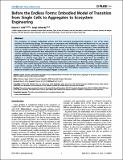Por favor, use este identificador para citar o enlazar a este item:
http://hdl.handle.net/10261/111635COMPARTIR / EXPORTAR:
 SHARE SHARE
 CORE
BASE CORE
BASE
|
|
| Visualizar otros formatos: MARC | Dublin Core | RDF | ORE | MODS | METS | DIDL | DATACITE | |

| Título: | Before the Endless Forms: Embodied Model of Transition from Single Cells to Aggregates to Ecosystem Engineering |
Autor: | Solé, Ricard V. CSIC ORCID ; Valverde, Sergi CSIC ORCID | Fecha de publicación: | 15-abr-2013 | Editor: | Public Library of Science | Citación: | PLoS ONE 8(4): e59664 (2013) | Resumen: | The emergence of complex multicellular systems and their associated developmental programs is one of the major problems of evolutionary biology. The advantages of cooperation over individuality seem well known but it is not clear yet how such increase of complexity emerged from unicellular life forms. Current multicellular systems display a complex cell-cell communication machinery, often tied to large-scale controls of body size or tissue homeostasis. Some unicellular life forms are simpler and involve groups of cells cooperating in a tissue-like fashion, as it occurs with biofilms. However, before true gene regulatory interactions were widespread and allowed for controlled changes in cell phenotypes, simple cellular colonies displaying adhesion and interacting with their environments were in place. In this context, models often ignore the physical embedding of evolving cells, thus leaving aside a key component. The potential for evolving pre-developmental patterns is a relevant issue: how far a colony of evolving cells can go? Here we study these pre-conditions for morphogenesis by using CHIMERA, a physically embodied computational model of evolving virtual organisms in a pre-Mendelian world. Starting from a population of identical, independent cells moving in a fluid, the system undergoes a series of changes, from spatial segregation, increased adhesion and the development of generalism. Eventually, a major transition occurs where a change in the flow of nutrients is triggered by a sub-population. This ecosystem engineering phenomenon leads to a subsequent separation of the ecological network into two well defined compartments. The relevance of these results for evodevo and its potential ecological triggers is discussed. © 2013 Solé, Valverde. | Versión del editor: | http://dx.doi.org/10.1371/journal.pone.0059664 | URI: | http://hdl.handle.net/10261/111635 | DOI: | 10.1371/journal.pone.0059664 | Identificadores: | doi: 10.1371/journal.pone.0059664 issn: 1932-6203 |
| Aparece en las colecciones: | (IBE) Artículos |
Ficheros en este ítem:
| Fichero | Descripción | Tamaño | Formato | |
|---|---|---|---|---|
| single_cells_Sole.pdf | 1,92 MB | Adobe PDF |  Visualizar/Abrir |
CORE Recommender
PubMed Central
Citations
5
checked on 24-mar-2024
SCOPUSTM
Citations
14
checked on 15-abr-2024
WEB OF SCIENCETM
Citations
13
checked on 22-feb-2024
Page view(s)
332
checked on 24-abr-2024
Download(s)
259
checked on 24-abr-2024
Google ScholarTM
Check
Altmetric
Altmetric
Artículos relacionados:
NOTA: Los ítems de Digital.CSIC están protegidos por copyright, con todos los derechos reservados, a menos que se indique lo contrario.
